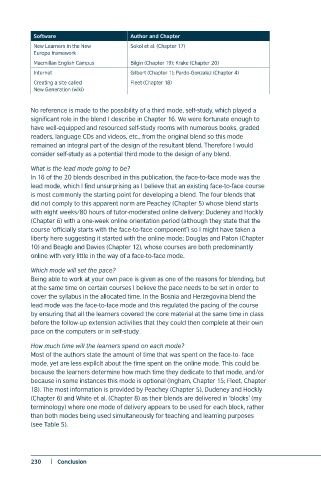Page 233 - BLENDED LEARNING
P. 233
Software Author and Chapter
New Learners in the New Sokol et al. (Chapter 17)
Europe framework
Macmillan English Campus Bilgin (Chapter 19); Krake (Chapter 20)
Internet Gilbert (Chapter 1); Pardo-Gonzalez (Chapter 4)
Creating a site called Fleet (Chapter 18)
New Generation (wiki)
No reference is made to the possibility of a third mode, self-study, which played a
significant role in the blend I describe in Chapter 16. We were fortunate enough to
have well-equipped and resourced self-study rooms with numerous books, graded
readers, language CDs and videos, etc., from the original blend so this mode
remained an integral part of the design of the resultant blend. Therefore I would
consider self-study as a potential third mode to the design of any blend.
What is the lead mode going to be?
In 16 of the 20 blends described in this publication, the face-to-face mode was the
lead mode, which I find unsurprising as I believe that an existing face-to-face course
is most commonly the starting point for developing a blend. The four blends that
did not comply to this apparent norm are Peachey (Chapter 5) whose blend starts
with eight weeks/80 hours of tutor-moderated online delivery; Dudeney and Hockly
(Chapter 6) with a one-week online orientation period (although they state that the
course ‘officially starts with the face-to-face component’) so I might have taken a
liberty here suggesting it started with the online mode; Douglas and Paton (Chapter
10) and Beagle and Davies (Chapter 12), whose courses are both predominantly
online with very little in the way of a face-to-face mode.
Which mode will set the pace?
Being able to work at your own pace is given as one of the reasons for blending, but
at the same time on certain courses I believe the pace needs to be set in order to
cover the syllabus in the allocated time. In the Bosnia and Herzegovina blend the
lead mode was the face-to-face mode and this regulated the pacing of the course
by ensuring that all the learners covered the core material at the same time in class
before the follow-up extension activities that they could then complete at their own
pace on the computers or in self-study.
How much time will the learners spend on each mode?
Most of the authors state the amount of time that was spent on the face-to- face
mode, yet are less explicit about the time spent on the online mode. This could be
because the learners determine how much time they dedicate to that mode, and/or
because in some instances this mode is optional (Ingham, Chapter 15; Fleet, Chapter
18). The most information is provided by Peachey (Chapter 5), Dudeney and Hockly
(Chapter 6) and White et al. (Chapter 8) as their blends are delivered in ‘blocks’ (my
terminology) where one mode of delivery appears to be used for each block, rather
than both modes being used simultaneously for teaching and learning purposes
(see Table 5).
230 | Conclusion

